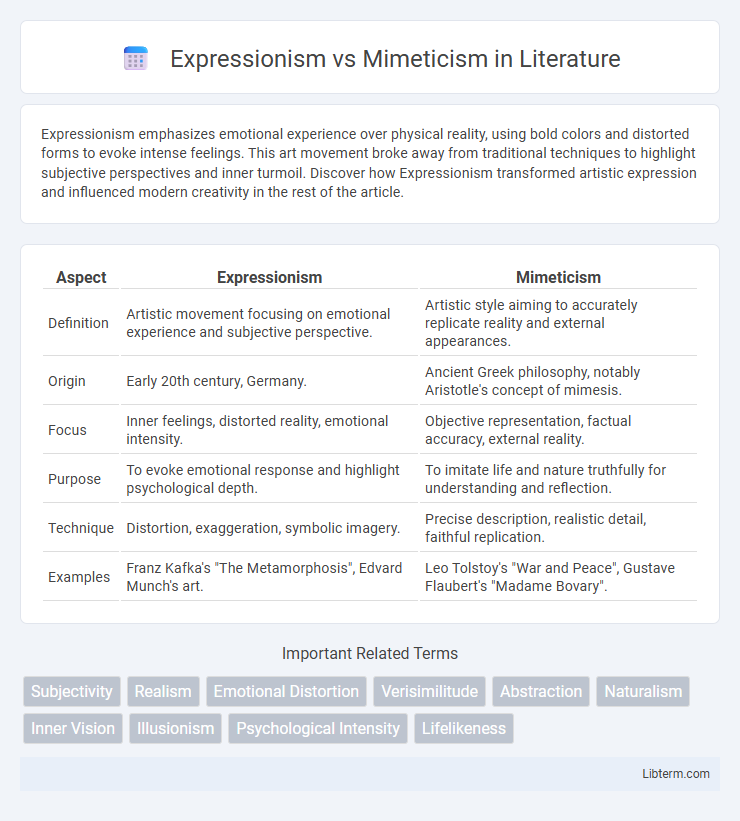Expressionism emphasizes emotional experience over physical reality, using bold colors and distorted forms to evoke intense feelings. This art movement broke away from traditional techniques to highlight subjective perspectives and inner turmoil. Discover how Expressionism transformed artistic expression and influenced modern creativity in the rest of the article.
Table of Comparison
| Aspect | Expressionism | Mimeticism |
|---|---|---|
| Definition | Artistic movement focusing on emotional experience and subjective perspective. | Artistic style aiming to accurately replicate reality and external appearances. |
| Origin | Early 20th century, Germany. | Ancient Greek philosophy, notably Aristotle's concept of mimesis. |
| Focus | Inner feelings, distorted reality, emotional intensity. | Objective representation, factual accuracy, external reality. |
| Purpose | To evoke emotional response and highlight psychological depth. | To imitate life and nature truthfully for understanding and reflection. |
| Technique | Distortion, exaggeration, symbolic imagery. | Precise description, realistic detail, faithful replication. |
| Examples | Franz Kafka's "The Metamorphosis", Edvard Munch's art. | Leo Tolstoy's "War and Peace", Gustave Flaubert's "Madame Bovary". |
Introduction to Expressionism and Mimeticism
Expressionism emphasizes subjective experience and emotional intensity, using distorted forms and vibrant colors to convey inner feelings rather than objective reality. Mimeticism, rooted in the imitation of the external world, aims to represent subjects with accuracy and detailed realism, reflecting observable phenomena. These contrasting approaches highlight the fundamental tension between emotional interpretation and faithful representation in art.
Historical Origins of Expressionism
Expressionism emerged in early 20th-century Germany as a reaction against the naturalism and realism dominant in Mimeticism, emphasizing subjective experience and emotional intensity over objective representation. Rooted in the socio-political upheavals and artistic movements like Symbolism and Fauvism, Expressionism sought to convey inner turmoil and raw human emotion through distorted forms and vivid colors. Key artists such as Edvard Munch and Ernst Ludwig Kirchner pioneered this style, challenging the mimetic ideals by prioritizing psychological depth and personal vision.
The Roots and Development of Mimeticism
Mimeticism traces its roots to classical Greek philosophy, emphasizing the imitation of reality as the foundation of art. The development of mimeticism evolved through the Renaissance, where artists sought precise representation and naturalism, advancing techniques in perspective and anatomy to mirror the observable world. This artistic approach prioritizes faithful depiction of subjects, contrasting with expressionism's emphasis on emotional experience and subjective interpretation.
Key Philosophical Differences
Expressionism prioritizes the artist's subjective emotions and inner experiences, emphasizing distortion and abstraction to evoke emotional responses. Mimeticism centers on accurate representation and faithful imitation of reality, aiming for objective depiction and external truth. The philosophical difference lies in Expressionism's focus on personal interpretation versus Mimeticism's commitment to objective replication of the external world.
Major Artists and Works: Expressionism
Expressionism, a movement emphasizing emotional experience over physical reality, features major artists like Edvard Munch, whose iconic work "The Scream" captures intense psychological tension. Wassily Kandinsky, often regarded as a pioneer of abstract Expressionism, created vibrant compositions such as "Composition VII" that convey deep spiritual and emotional states. Egon Schiele's raw, distorted figures in works like "Self-Portrait with Physalis" exemplify the movement's focus on subjective feelings and inner turmoil.
Major Artists and Works: Mimeticism
Mimeticism, rooted in realistic representation, found its major proponents in artists such as Johannes Vermeer, Diego Velazquez, and Jean-Baptiste-Camille Corot, whose paintings emphasize detailed accuracy and lifelike portrayal. Vermeer's "Girl with a Pearl Earring" exemplifies the precision and subtle light effects characteristic of mimetic art, while Velazquez's "Las Meninas" showcases complex spatial composition and realism. Corot's landscapes like "Ville d'Avray" highlight naturalistic detail and atmospheric effects, reinforcing mimeticism's dedication to replicating the visible world.
Techniques and Stylistic Elements
Expressionism emphasizes distorted forms, bold colors, and exaggerated brushstrokes to evoke emotional responses, often using abstraction to convey subjective experiences. Mimeticism prioritizes realistic representation through precise detail, accurate perspective, and naturalistic color palettes that replicate the visible world. Techniques in Expressionism rely on spontaneity and emotional intensity, while Mimeticism employs meticulous observation and technical skill to achieve lifelike depictions.
Influence on Modern and Contemporary Art
Expressionism profoundly shaped modern and contemporary art by emphasizing emotional experience and subjective interpretation, influencing movements such as Abstract Expressionism and Neo-Expressionism. Mimeticism, centered on realistic representation and accurate depiction, informed hyperrealism and photorealism, driving artists to explore precision and detail. Both styles continue to impact artistic practices by defining divergent approaches to creativity, perception, and audience engagement in visual culture.
Critical Reception and Debates
Expressionism, characterized by its emphasis on subjective emotional experience and distortion of reality, has often been praised for its innovative departure from traditional representational art, sparking debates about the value of emotional authenticity over accurate depiction. Mimeticism, with its focus on faithful representation of the external world, has faced criticism regarding limitations in conveying deeper psychological or emotional truths, leading to ongoing discussions about the purpose and function of art. Critical reception continuously grapples with whether art should mirror reality or evoke inner experiences, influencing movements and theoretical discourses in modern and contemporary aesthetics.
Conclusion: Navigating Between Expression and Imitation
Expressionism captures the artist's subjective emotions and inner experiences, emphasizing bold colors and distorted forms to evoke a personal response. Mimeticism focuses on precise imitation of reality, aiming to replicate the external world with accuracy and detail. Balancing expression and imitation involves understanding the purpose of art--whether to convey internal truths or reflect external appearances--allowing artists to choose techniques aligned with their creative intent.
Expressionism Infographic

 libterm.com
libterm.com